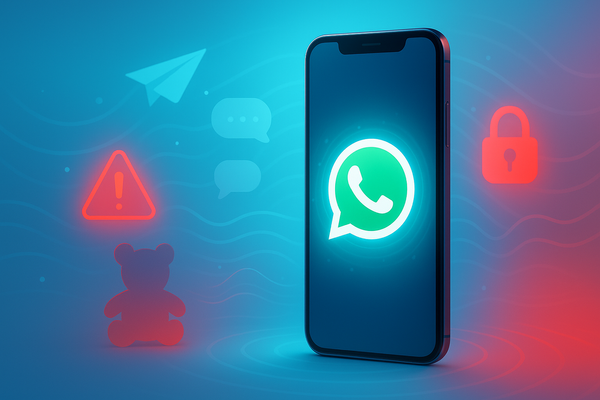How Kids Get Automatically Added Into WhatsApp Groups with Horrific Imagery Without Consent

Children across the world are being added without their consent to WhatsApp groups that share explicit or violent material, including horrific imagery and pornography.
The problem arises from the platform’s default privacy settings, which allow anyone with a user’s phone number to add them to group chats.
Unmoderated spaces can expose children to inappropriate content, digital grooming, and peer pressure. The fact that groups are also subject to end-to-end encryption also means Meta technically can’t really see what’s happening.
How the Problem Starts
Picture your kid checking their phone and finding they’ve been added to a WhatsApp group that features horrific pictures, videos, GIFs and stickers. They didn’t join the group. They didn’t agree to be a part of it, but it happens nonetheless.
For example, across multiple schools in the UK, police confirmed that children as young as nine years old are being added to WhatsApp groups sharing pornography and violent imagery.
The problem lies in the default group settings, which are set to “Everyone,” allowing anyone with your number to add you to a WhatsApp group.
For adults, it’s a convenience. For children, it’s a vulnerability.
The problem is aggravated by Meta’s decision to lower the minimum age of users from 16 to 13. Many kids join to stay connected with classmates, unaware of the hidden risks.
Once a child’s phone number circulates among friends, school lists, or public profiles, strangers can use it to add them to massive groups filled with unknown participants.
Because WhatsApp uses end-to-end encryption, Meta can’t scan messages or media proactively. This means explicit photos, links, and even predatory messages can circulate freely before anyone notices, including parents.
What Happens Inside These Groups
Inside, children encounter:
- Pornographic images and videos are shared without warning
- Violent and self-harm content disguised as “memes”
- Strangers asking for personal photos or school details
- Peer pressure to stay in the group to “fit in”
For some children, the shock of seeing explicit material can lead to anxiety, fear, and long-term emotional distress. And because WhatsApp automatically downloads media by default, those images may also end up stored in the phone’s gallery.
What Parents Can Do Right Now
1. Lock Down Group Invites
Open WhatsApp → Settings → Privacy → Groups → choose “My Contacts” or “My Contacts Except…” instead of Everyone. This stops strangers from automatically adding your child. Instead, they’ll receive an invite link they can accept or decline.

The feature that lets users decide who can add numbers to WhatsApp groups has been around since 2019, but it's set to Everyone by default.
2. Disable Automatic Media Downloads
Turn off automatic photo and video downloads. This prevents explicit material from being saved to the camera roll, even if it appears in a chat.
3. Tighten Profile Visibility
Set “Last Seen,” “Profile Photo,” and “About” to “My Contacts” or “Nobody.” This hides identifying information from strangers who might use it to target kids.
4. Teach Reporting and Blocking
Show your child how to leave, block, and report groups or users that share inappropriate content.
How Bitdefender Helps Families Stay Safe
Even with careful parenting, you can’t monitor every chat; and it’s not healthy for the relationship with a child. Bitdefender’s Parental Control suite gives you an extra layer of protection:
- Alerts when new or risky apps are installed.
- Tools to monitor screen time and block inappropriate web content.
- Remote activity insights without invading privacy.
Bitdefender complements WhatsApp’s privacy settings by safeguarding your child’s entire device.
WhatsApp FAQ
- Can anyone add my child to a WhatsApp group?
Yes. Unless you change the privacy setting, anyone who knows your child’s phone number can add them without consent.
- What kind of content has been reported?
Police have identified groups sharing pornographic videos, violent clips, and hate content aimed at younger users.
- Does WhatsApp monitor these groups?
No. Because of encryption, WhatsApp can’t see inside private chats or groups. Harmful material can spread before it’s reported.
- What’s the legal minimum age for WhatsApp?
In most countries, it’s 13, though previously it was 16 in Europe. Enforcement relies on users self-reporting their age, so younger kids often bypass it.
- Should I ban WhatsApp completely?
Not necessarily. The goal isn’t total restriction, but guided safety.
tags
Author
Silviu is a seasoned writer who followed the technology world for almost two decades, covering topics ranging from software to hardware and everything in between.
View all postsRight now Top posts
How Kids Get Automatically Added Into WhatsApp Groups with Horrific Imagery Without Consent
November 24, 2025
Scammers Exploit Hype Around Starbucks Bearista Cup to Steal Data and Money, Bitdefender Antispam Lab Warns
November 18, 2025
Scam Alert: Fake Sephora Advent Calendar Ads and WhatsApp Messages Flood Europe in 2025
November 17, 2025
ClickFix Malware Chain Expands: Fake TradingView and Sora 2 Ads On Meta Now Target macOS Users
November 17, 2025
FOLLOW US ON SOCIAL MEDIA
You might also like
Bookmarks






